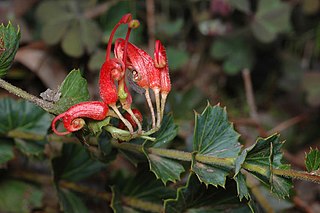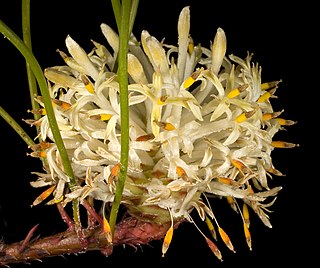Banksia fasciculata is a species of column-shaped shrub that is endemic to Western Australia. It has hairy stems, crowded, prickly leaves, yellow flowers and hairy fruit.
Banksia idiogenes is a species of tufted shrub that is endemic to Western Australia. It has hairy stems, deeply pinnatifid leaves, distinctive, scented, red and white flowers in heads of about eighty, later several glabrous, egg-shaped follicles in each head.
Banksia ionthocarpa is a species of shrub that is endemic to Western Australia. It has short, hairy, prostrate stems, pinnatifid leaves, pinkish purple to orange flower in heads of between forty and sixty at the base of leaves, and egg-shaped follicles with a distinctive tuft of hairs on the end.

Banksia serratuloides is a species of small shrub that is endemic to Western Australia. It has linear, pinnatipartite leaves, yellow and pink flowers in heads of about forty and hairy, wrinkled follicles.
Verticordia aereiflora is a flowering plant in the myrtle family, Myrtaceae and is endemic to the south-west of Western Australia. It is a thin but bushy shrub with small leaves and greenish-yellow flowers with red spots and red fringes on the sepals.
Verticordia amphigia commonly known as pixie ears is a flowering plant in the myrtle family, Myrtaceae and is endemic to the south-west of Western Australia. It is usually an open, much-branched shrub with narrow leaves and yellow flowers which sometimes produce a "sea" of colour in the wild. The flowers are surrounded by boat-shaped bracteoles which give the plant both its common and scientific names.

Daviesia triflora is a species of flowering plant in the family Fabaceae and is endemic to South West Australia. It is a rush-like, leafless shrub with many stems, and orange-yellow and dark flowers.

Grevillea infundibularis, commonly known as fan-leaf grevillea, is a species of flowering plant in the family Proteaceae and is endemic to a restricted area in the south of Western Australia. It is a spreading to low-lying shrub with egg-shaped to hemispherical leaves and clusters of four to eight bright red flowers.
Persoonia manotricha is a species of flowering plant in the family Proteaceae and is endemic to Western Australia. It is an erect shrub with hairy young branchlets, more or less cylindrical leaves and greenish yellow flowers in groups of up two to eight on a rachis 2–15 mm (0.079–0.591 in) long. It is similar to P. bowgada and P. hexagona but has longer pedicels than P. bowgada and differently grooved leaves from P. hexagona.
Verticordia comosa is a flowering plant in the myrtle family, Myrtaceae and is endemic to the south-west of Western Australia. It is an openly branched shrub with small, broad, almost round leaves and spikes of flowers that are pale yellow, sometimes with a white or pale pink centre.

Grevillea coccinea is a species of flowering plant in the family Proteaceae and is endemic to the south of Western Australia. It is a low-lying or sprawling shrub with narrowly wedge-shaped to linear leaves and white, cream-coloured, and red or yellow flowers.
Grevillea fuscolutea is a species of flowering plant in the family Proteaceae and is endemic to a small area in the south-west of Western Australia. It is an erect shrub with egg-shaped to more or less linear leaves, and dull yellow-orange flowers.

Petrophile prostrata is a species of flowering plant in the family Proteaceae and is endemic to southwestern Western Australia. It is a prostrate shrub with needle-shaped but usually not sharply-pointed leaves and spherical heads of hairy, pale yellow or cream-coloured flowers.
Goodenia halophila is a species of flowering plant in the family Goodeniaceae and is endemic to the northern Australia. It is a delicate annual herb with spatula-shaped, or lance-shaped leaves in a tuft at the base of erect or low-lying flowering stems, and cymes of yellow flowers.
Pultenaea craigiana is a species of flowering plant in the family Fabaceae and is endemic to near Ravensthorpe in the south of Western Australia. It is an erect, spindly shrub with densely hairy young stems, egg-shaped leaves with the narrower end towards the base, and yellow and red flowers.
Pultenaea indira is a species of flowering plant in the family Fabaceae and is endemic to the south-west of Western Australia. It is an erect or low-lying shrub with plate-like or fissured bark near the base, densely hairy stems above, linear to lance-shaped leaves with the narrower end towards the base, and yellow, red and maroon flowers.
Lasiopetalum ferraricollinum is a species of flowering plant in the family Malvaceae and is endemic to the south-west of Western Australia. It is an upright shrub with densely hairy stems, narrow egg-shaped to oblong leaves and white to cream-coloured and dark red flowers.

Lasiopetalum glabratum is a species of flowering plant in the family Malvaceae and is endemic to the south-west of Western Australia. It is an erect shrub with densely hairy young stems, egg-shaped leaves and pale mauve-pink reddish-purple flowers.

Lasiopetalum venustum is a species of flowering plant in the family Malvaceae and is endemic to a restricted area in the south-west of Western Australia. It is an erect shrub with hairy stems, egg-shaped, three-lobed leaves and pink and dark red flowers.
Sphaerolobium acanthos, commonly known as Grampians globe-pea, is a species of flowering plant in the family Fabaceae and is endemic to a restricted part of the Grampians National Park in Victoria. It is an erect, wiry shrub with many spiny branchlets, scattered tapering leaves, and yellow, orange or reddish-brown flowers.







